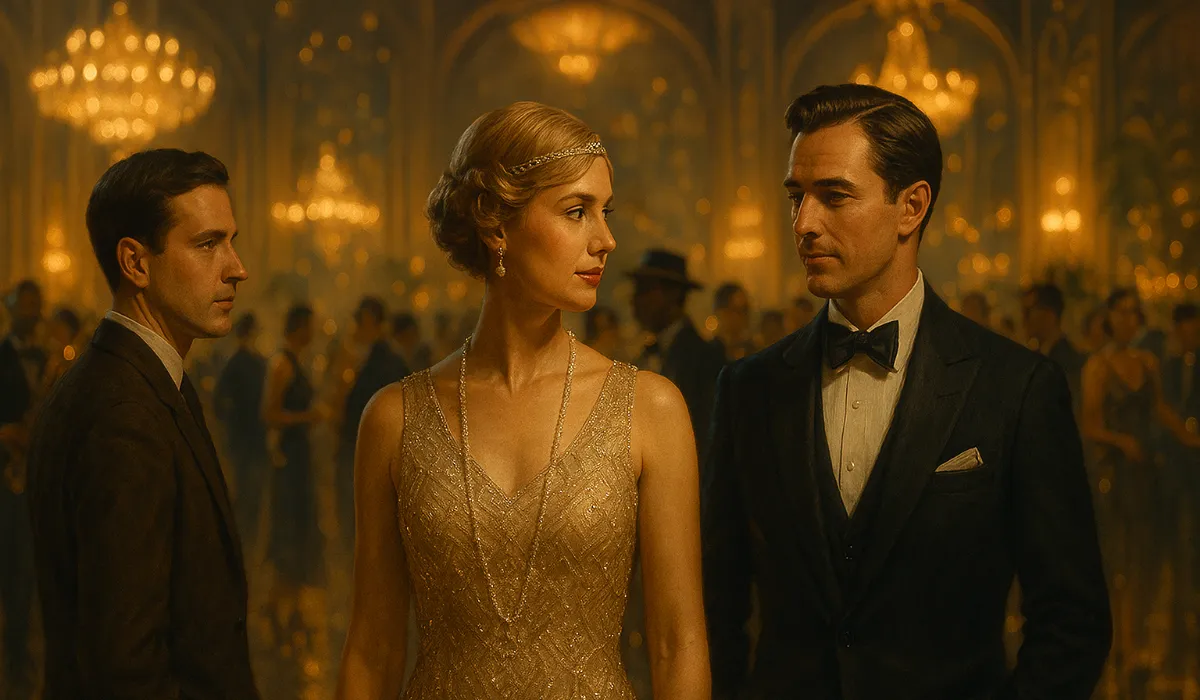The Great Gatsby
The Great Gatsby by F. Scott Fitzgerald is a timeless classic. Set in the Jazz Age1 on Long Island, near New York City, the novel depicts first-person narrator Nick Carraway’s interactions with Jay Gatsby, a mysterious millionaire obsessed with reuniting with his former lover, Daisy Buchanan.
Nick Carraway is a Yale University alumnus from the American Midwest, a World War-I veteran, and a newly arrived resident of West Egg on Long Island, near New York City. He is a bond salesman and the neighbor of enigmatic millionaire Jay Gatsby.
Jay Gatsby is an enigmatic nouveau riche millionaire who lives in a Long Island mansion where he often hosts extravagant parties and who allegedly gained his fortune by illicit bootlegging during prohibition in the United States.
Daisy Fay Buchanan is a wealthy socialite from Louisville, Kentucky who resides in the fashionable, “old money” town of East Egg on Long Island. She is Nick Carraway’s second cousin, once removed, and the wife of polo player Tom Buchanan, with whom she has a daughter named Pammy. Before marrying Tom, Daisy had a romantic relationship with poor doughboy Jay Gatsby. Her choice between Gatsby and Tom becomes the novel’s central conflict.
Gatsby exemplifies an era obsessed with appearances, opulence, and reinvention—a theme perfectly mirrored today in our obsession with curated digital identities and AI-enhanced lifestyles. Online platforms, driven by sophisticated algorithms, curate glamorous illusions similar to Gatsby’s glittering soirées, masking underlying loneliness and dissatisfaction. In a striking parallel, our carefully filtered online personas strive to attract admiration, mirroring Gatsby’s carefully engineered facade to impress Daisy.
“I was within and without, simultaneously enchanted and repelled by the inexhaustible variety of life.”
Beneath Gatsby’s polished exterior lies profound emptiness, a man perpetually haunted by his inability to recapture the past. And in today’s world, consider our own AI-driven ambitions, which often overlook critical human aspects. Companies leveraging AI promise unparalleled convenience, connection, and progress. Yet, like Gatsby’s quest, this pursuit usually masks more profound existential anxieties about authenticity and human connection.

AI’s Gatsby
AI’s prowess in generating near-human interactions has become a modern-day Gatsby—seductive, impressive, yet fundamentally detached from genuine human intimacy and depth. As Gatsby’s wealth cannot truly buy him Daisy’s love, no amount of AI-generated sophistication can fully replicate genuine human relationships and empathy.
Gatsby’s tragedy is rooted in his misguided belief in boundless promise, blind to its inherent flaws and limitations. Today, AI evangelists often similarly extol artificial intelligence as an endless horizon of innovation. However, the reality includes stark ethical dilemmas, from deepfakes undermining trust to AI-driven job displacement fueling social divides.
“I felt a haunting loneliness sometimes, and felt it in others–young clerks in the dusk, wasting the most poignant moments of night and life.”
Interestingly, Gatsby’s downfall isn’t merely his personal tragedy but a critique of society’s broader negligence towards ethics and empathy. Our fascination with AI’s capabilities often eclipses discussions around its ethical implications, privacy concerns, and broader societal impacts.
In essence, The Great Gatsby serves as a timeless cautionary tale that remains astonishingly relevant. Gatsby’s glittering yet hollow dream parallels our own AI-driven pursuits—impressive in scope, seductive in promise, yet fraught with moral and existential dilemmas.
Revisiting this masterpiece in our current era offers critical lessons: the importance of grounding technological ambitions in human empathy, ethical mindfulness, and a realistic grasp of limitations.
Ultimately, as Gatsby tragically learned, unchecked ambition can lead to ruin. Similarly, without mindful stewardship, our AI-driven age could find itself chasing after shimmering dreams—only to awaken disillusioned, facing the consequences we never anticipated.
-
The Jazz Age was a period from 1920 to the early 1930s in which Jazz music and dance styles gained worldwide popularity. The Jazz Age’s cultural repercussions were primarily felt in the United States, the birthplace of jazz. Originating in New Orleans as mainly sourced from the culture of African Americans, jazz played a significant part in wider cultural changes in this period, and its influence on popular culture continued long afterwards. ↩